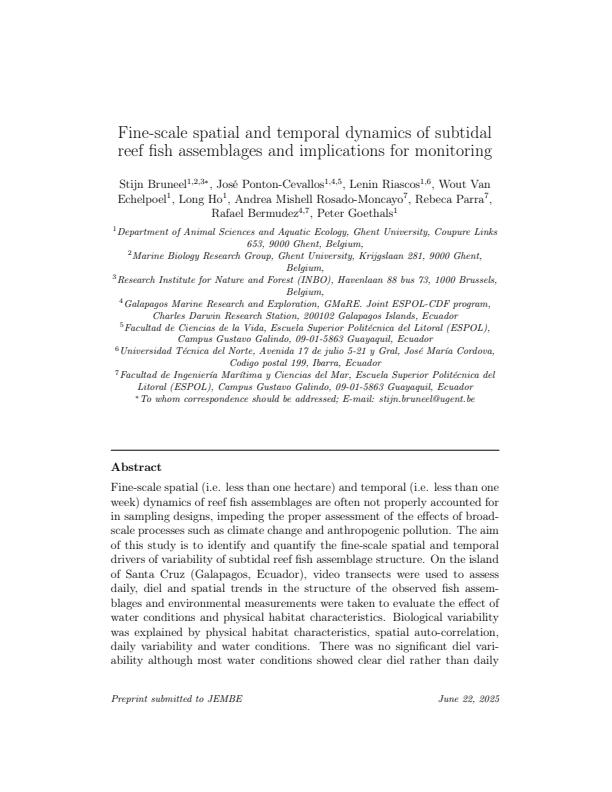Fine-scale spatial and temporal dynamics of subtidal reef fish assemblages and implications for monitoring
Details
| Volume | 587 |
|---|---|
| Type | A1: Web of Science-article |
| Category | Research |
| Magazine | Journal of Experimental Marine Biology and Ecology |
| Issns | 0022-0981|1879-1697 |
| Publisher | Elsevier Science |
| Language | English |
Bibtex
@misc{90ca0078-3b28-4a22-b0a9-2160c72fd48d,
title = "Fine-scale spatial and temporal dynamics of subtidal reef fish assemblages and implications for monitoring",
abstract = "Fine-scale spatial (i.e. less than one hectare) and temporal (i.e. less than one week) dynamics of reef fish assemblages are often not properly accounted for in sampling designs, impeding the proper assessment of the effects of broad-scale processes such as climate change and anthropogenic pollution. The aim of this study is to identify and quantify the fine-scale spatial and temporal drivers of variability of subtidal reef fish assemblage structure. On the island of Santa Cruz (Galapagos, Ecuador), video transects were used to assess daily, diel and spatial trends in the structure of the observed fish assemblages and environmental measurements were taken to evaluate the effect of water conditions and physical habitat characteristics. Biological variability was explained by physical habitat characteristics, spatial auto-correlation, daily variability and water conditions. There was no significant diel variability although most water conditions showed clear diel rather than daily trends, suggesting that the prevailing water conditions were not important at the studied scale. Fine-scale spatial variability in combination with daily fluctuations of the structure of reef fish assemblages are likely linked to food availability and fish movement. Studies aiming to understand broad-scale processes, while accounting for fine-scale variability, typically rely on labor intensive power and sample size estimations to guide the distribution of sampling effort. However, we show that fine-scale variability can be attributed up to 42 temporal and environmental drivers, thereby indicating that ecological knowledge can be used to select the most appropriate sampling design. Accounting for habitat characteristics and sampling variability, through multiple transects and repetitions respectively, proved most important in the study of reef fish assemblages of the Galapagos.",
author = "Stijn Bruneel and Jose Ponton-Cevallos and Lenin Riascos Flores and Wout Van Echelpoel and Long Ho and Andrea Mishell Rosado-Moncayo and Rebeca Parra and Rafael Bermudez and Peter Goethals",
year = "2025",
month = jun,
day = "01",
doi = "https://doi.org/10.1016/j.jembe.2025.152102",
language = "English",
publisher = "Elsevier Science",
address = "Belgium,
type = "Other"
}
Authors
Stijn BruneelJose Ponton-Cevallos
Lenin Riascos
Wout Van Echelpoel
Long Ho
Andrea Mishell Rosado-Moncayo
Rebeca Parra
Rafael Bermudez
Peter Goethals

